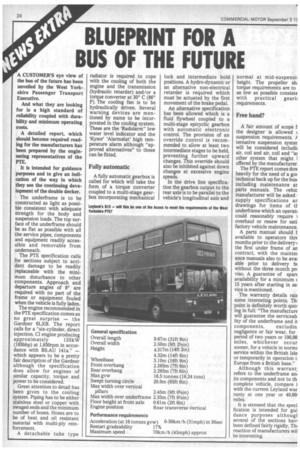BLUEPRINT FOR A BUS OF THE FUTURE
Page 22

If you've noticed an error in this article please click here to report it so we can fix it.
A CUSTOMER'S eye view of the bus of the future has been unveiled by the West York-, shire Passenger Transport Executive.
And what they are looking for is a high standard of reliability coupled with durability and minimum operating costs.
A detailed report, which should become required read ing for the manufacturers has been prepared by the engineering representatives of the PTE.
It is intended for guidance purposes and to give an indi cation of the way in which they see the continuing development of the double decker.
The underframe is to be constructed as light as possi ble consistent with adequate strength for the body and suspension loads. The top sur face of the underframe should be as flat as possible with all the service pipes, Components and equipment readily accessible and removable from underneath.
The PTE specification calls for sections subject to acci dent damage to be readily .replaceable with the minimum disturbance to other components. Approach and departure angles of 9° are required with no part of the frame or equipment fouled when the vehicle is fully laden. The engine recommended in the PTE specification comes as no great surprise — the Gardner 6LXB. The report calls for a "six-cylinder, direct injection, CI engine producing approximately 135kW (185bhp) at 1,850rpm in accor dance with BS.AU 14Ia," — which appears to be a pretty fair description of the Gardner although the specification does allow for engines of similar capacity, torque and power to be considered.
Great attention to detail has been given to the cooling system. Piping has to be either stainless steel or copper with swaged ends and the minimum number of hoses. Hoses are to be of heat and oil resistant material with multi-ply reinforcement.
A detachable tube type radiator is required to cope with the cooling of both the engine and the transmission (hydraulic retarder) and/or a torque converter at 30° C (86° F). The cooling fan is to be hydraulically driven. Several warning devices are mentioned by name to be incorporated in the cooling system. These are the 'Radolarm" low water level indicator and the `Kysor' 'Alarmstat' high temperature alarm although "approved alternatives" to these can be fitted.
Fully automatic
A fully automatic gearbox is called for which will take the form of a torque converter coupled to a multi-stage gearbox incorporating mechanical lock and intermediate hold positions. A hydro-dynamic or an alternative non-electrical retarder is required which must be actuated by the first movement of the brake pedal.
An alternative specification has been allowed which is a fluid flywheel coupled to a multi-stage epicyclic gearbox with automatic electronic control. The provision of an override control is recommended to allow at least two intermediate stages to be held, preventing further upward changes. This override should also be inhibited against down changes at excessive engine speeds.
In the drive line specification the gearbox output to the rear axle is to be parallel to the vehicle's longitudinal axis and normal at mid-suspensi4 height. The propeller sIL torque requirements are to as low as possible consiste with practical gearii requirements.
Free hand?
A fair amount of scope f the designer is allowed ( suspension requirements. A ternative suspension syster will be considered includii air, coil and air, coil and "al other system that might 1 offered by the manufacturer.
The PTE report comes dom heavily for the need of a goc technical back up for the bus, including maintenance ar parts manuals. The vehic manufacturer will be asked I supply specifications an drawings for items of a underframe which an operati could reasonably require i overhaul or renew for sati factory vehicle maintenance.
A parts manual should t available to operators thrE months prior to the delivery the first under frame of an contract, with the mainter ance manuals also to be avai able prior to delivery bi without the three month prc viso. A guarantee of spar( availability for a minimum 15 years after starting in sei vice is mentioned.
The warranty details rais some interesting points. Thi point is definitely worth quoi ing in full: "The manufactur€ will guarantee the serviceab lity of the underframe and it components, excludin negligence or fair wear, for period of two years or 100,00 miles, whichever occur sooner, for a vehicle in norms service within the British Isle or temporarily in operation ii Europe from a British base."
Although this warrant: refers to the underframe an its components and not to th, complete vehicle, compare i with the current Leyland war ranty at one year or 40,001 miles.
It is stressed that the speci fication is intended for gui dance purposes althougl several of the sections havi been defined fairly rigidly. Thi reaction of manufacturers wil be interesting.




















































































